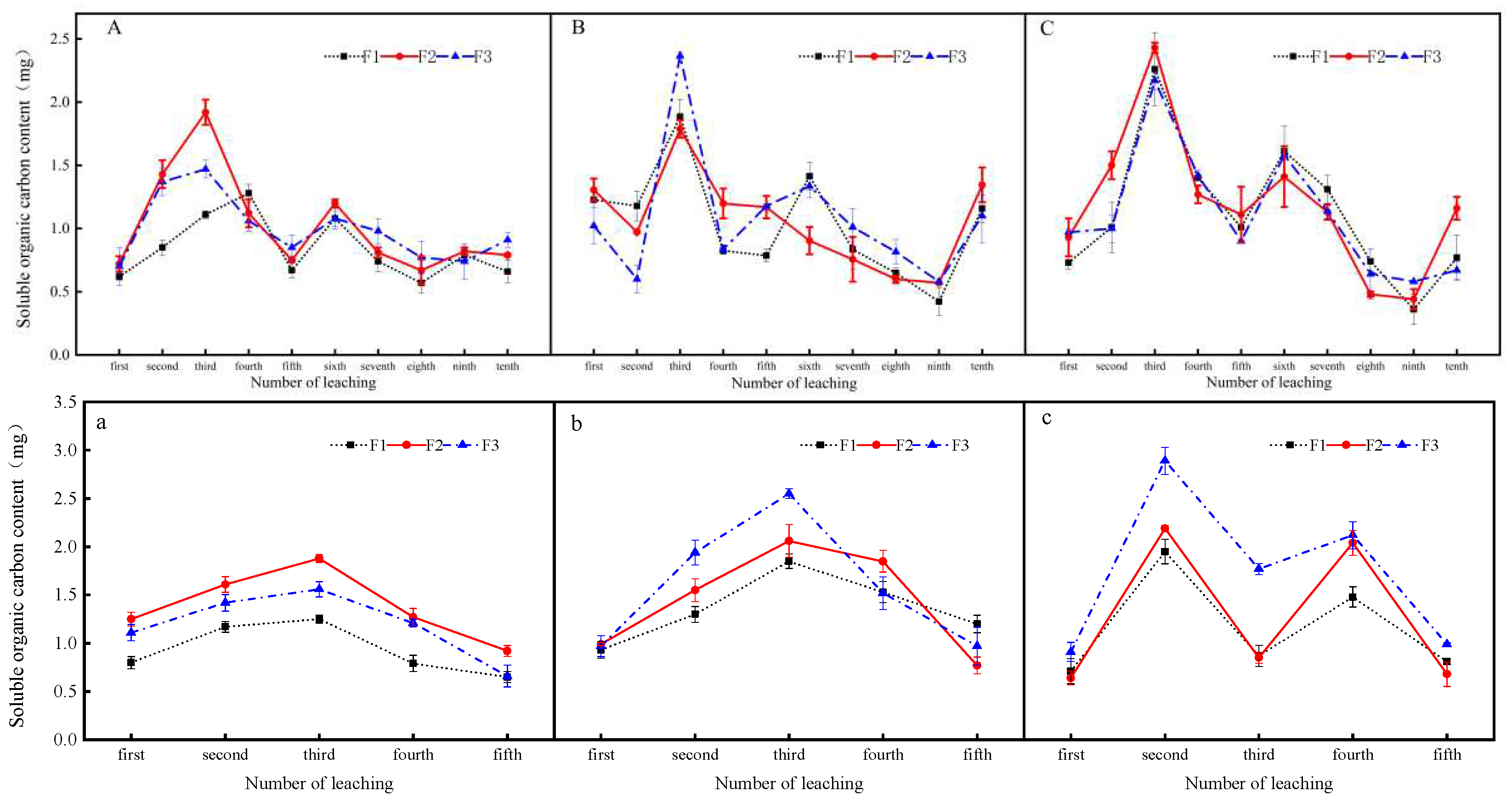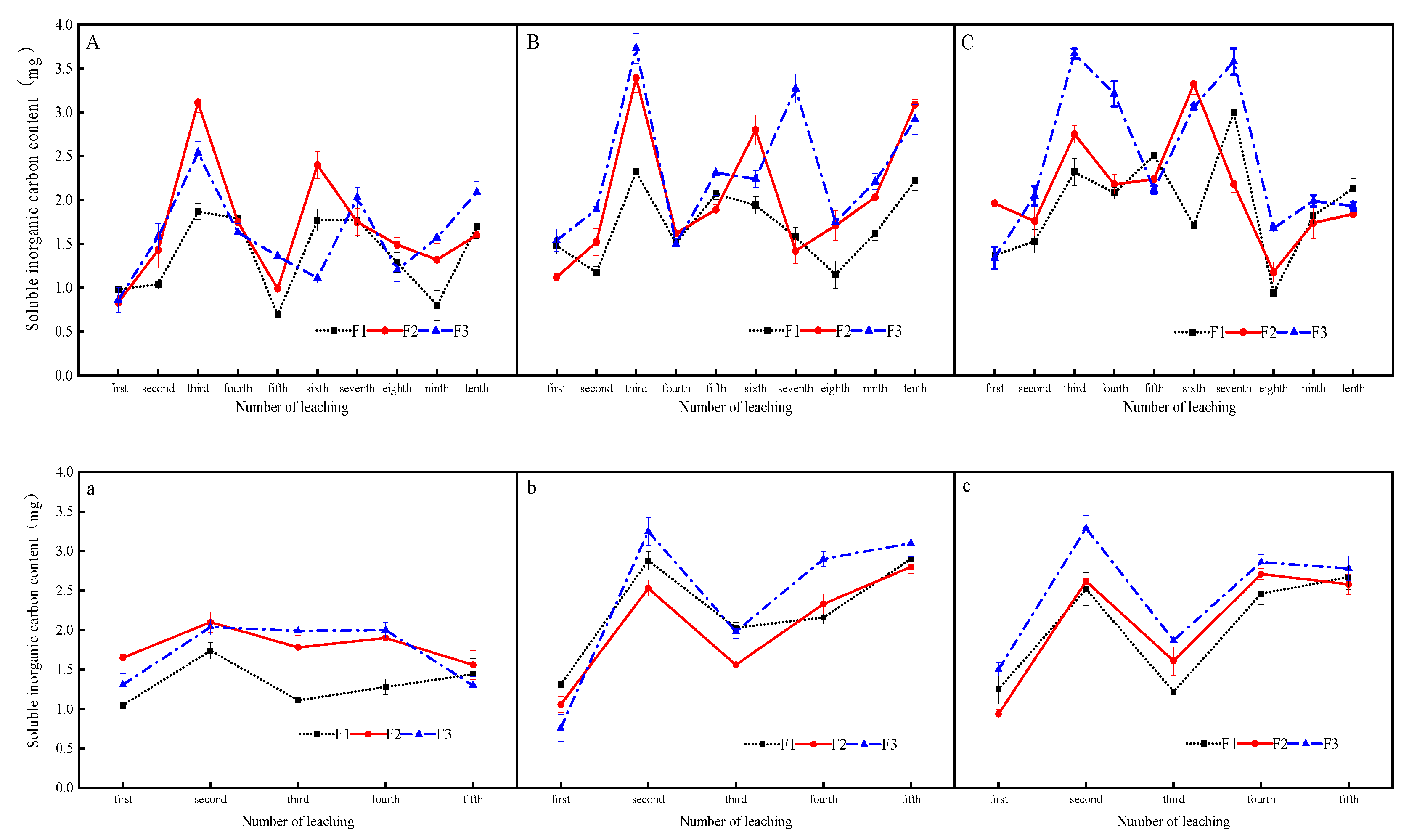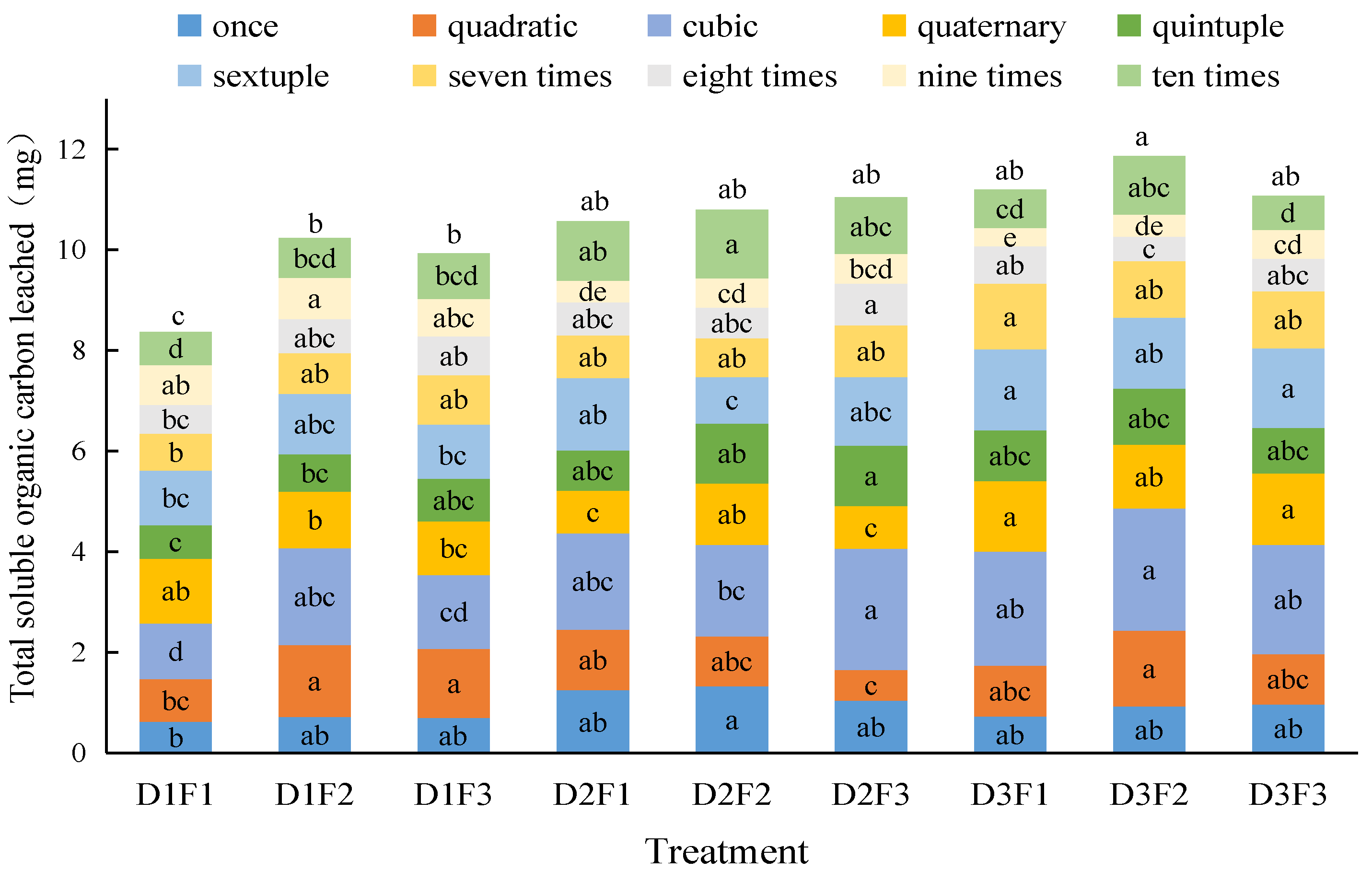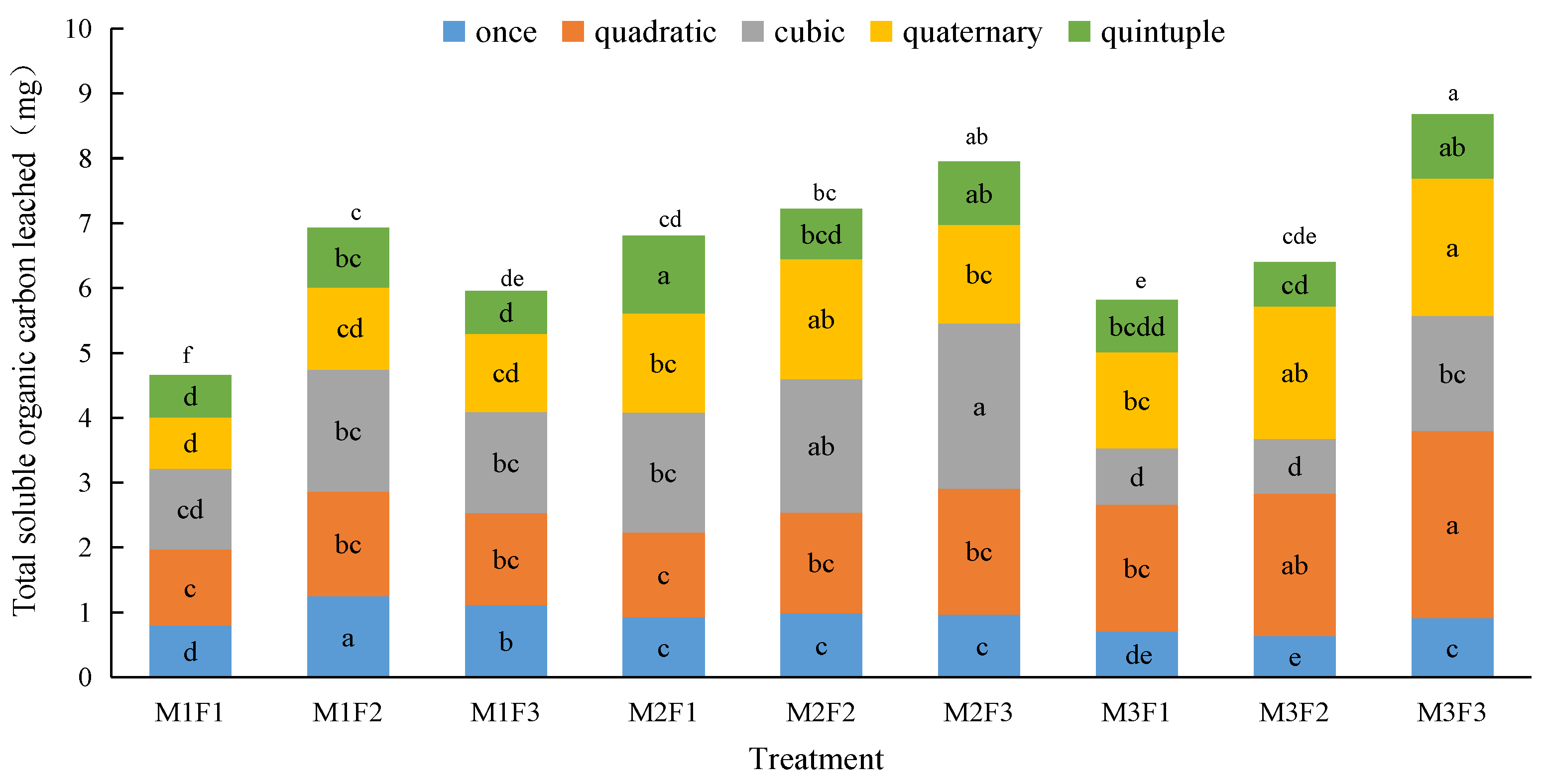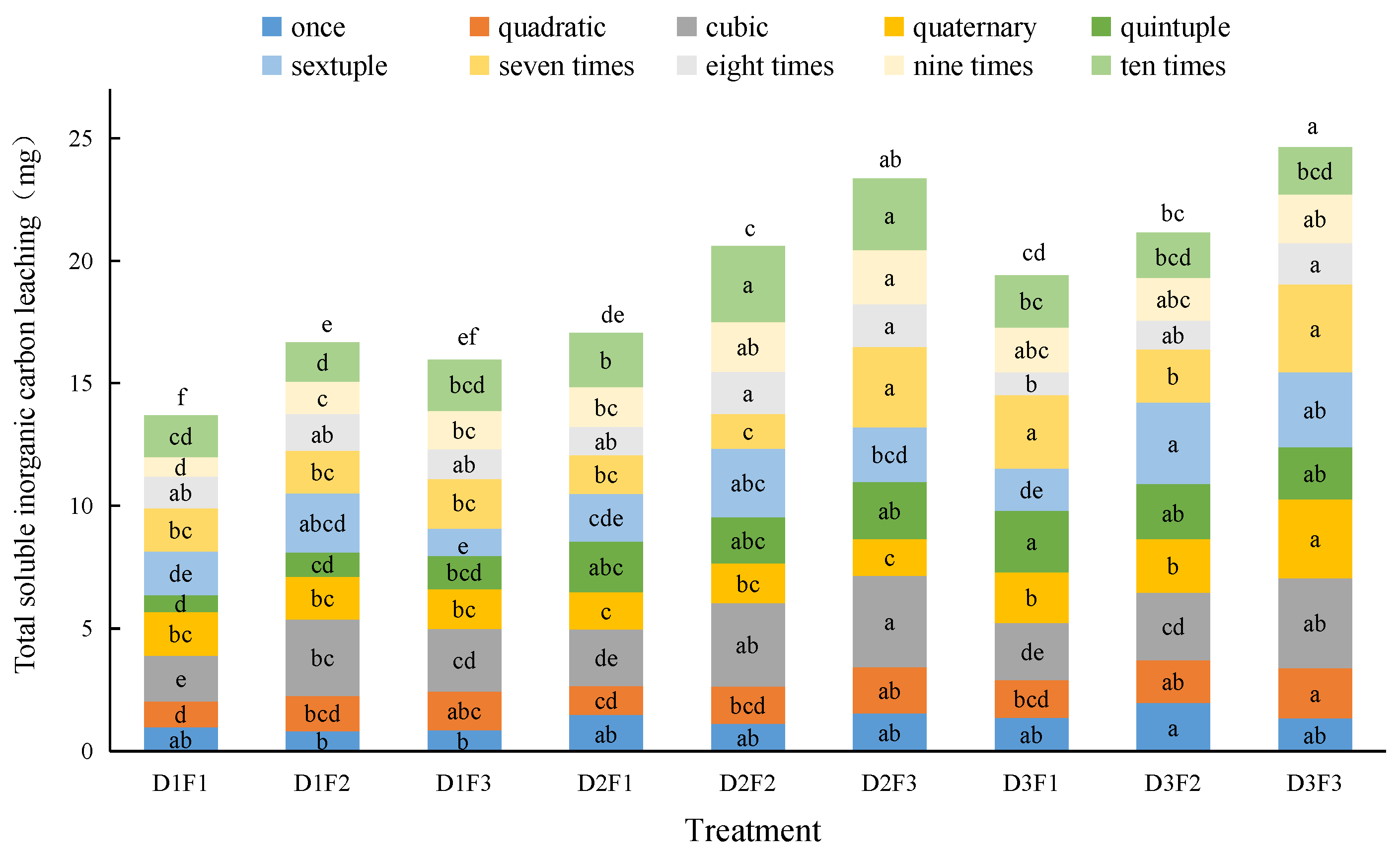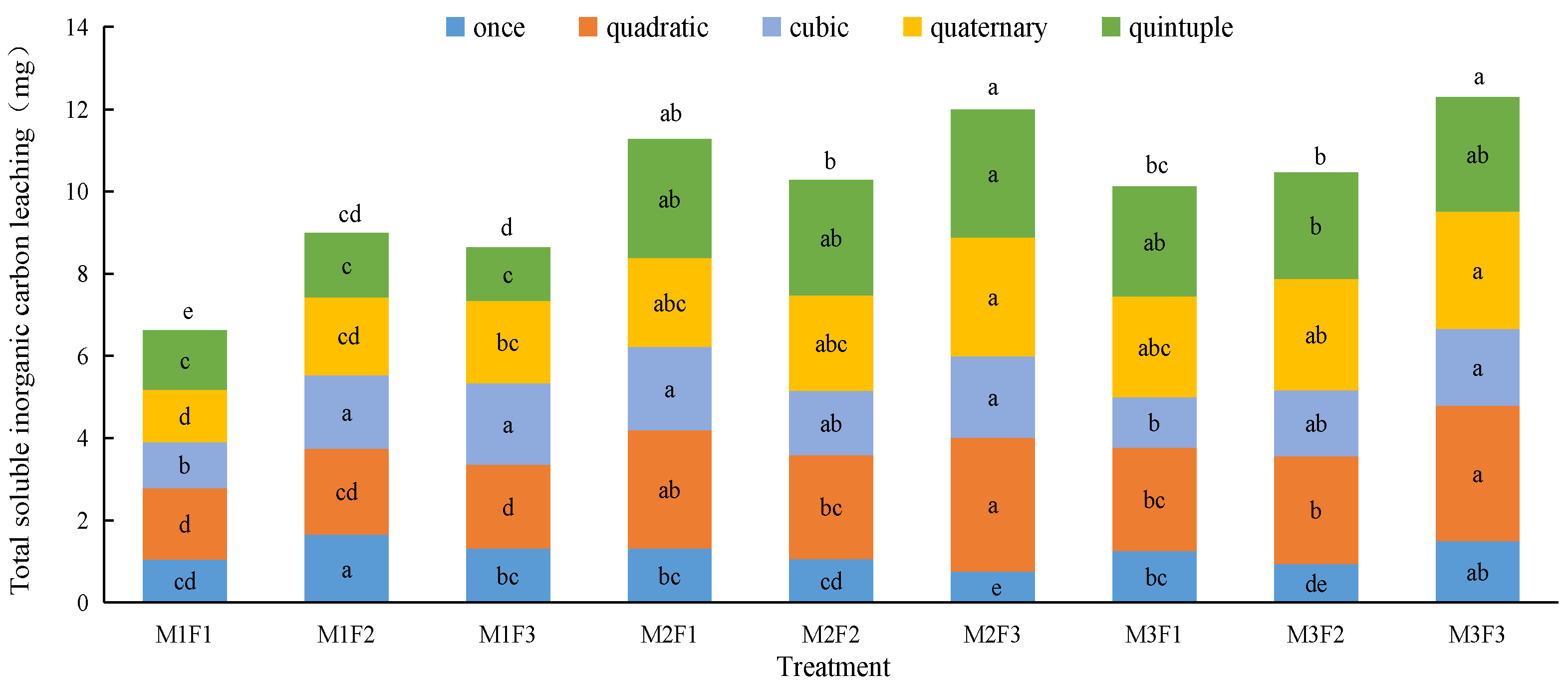Introduction
The carbon cycle is crucial to the impact of global climate change. The study of the global carbon cycle is one of the important concerns of scholars at home and abroad[
1,
2,
3]. Dissolved carbon is an important and active chemical component in terrestrial and aquatic ecosystems[
4,
5], including Dissolved Organic Carbon(DOC) and Dissolved Inorganic Carbon(DIC), which have different ecological and environmental effects. DOC has a high degree of fluidity and is a key link in the biogeochemical cycle. It plays an important role in the carbon cycle and distribution in the ecosystem. It can complex with pollutants such as pesticides and heavy metals and become a carrier for the migration of organic and inorganic pollutants[
6]. DIC is an important part of the carbon budget, which is crucial in regulating the carbon flux between the three major carbon pools and is a rich carbon pool in inland waters[
7]. The migration of DOC from terrestrial ecosystem to aquatic ecosystem will aggravate water pollution and soil carbon pool loss. Therefore, it is of great significance to strengthen the research on the leaching process of DOC and DIC in farmland soil and their regulatory pathways for the prevention and control of water environment pollution and soil carbon management from the source, and effective soil carbon leaching data can increase the accuracy of estimating the carbon balance of terrestrial ecosystems. It is the basis for further evaluation of carbon transport through soil between aquifer water and inland water[
8,
9].
The cotton area in the upper reaches of Tarim is the main high-quality cotton producing area in China. With the innovation of cotton planting mode, the irrigation mode has changed from flood irrigation to drip irrigation, from the previous four irrigations in the whole growth period to the current 8-12 drip irrigations. The cotton area is mainly reclaimed from wasteland, and increasing nitrogen fertilizer is an important crop yield increase measure in this area. Irrigation amount and fertilizer amount are the main factors affecting soil carbon migration in this area, but the effects of different water and nitrogen inputs and water input methods on soil carbon migration in this area have been rarely reported, and the surface soil organic carbon content in this area (generally less than 10 g/kg)is lower than other soil fertility in China.In addition to the climate, soil properties and farmland management measures in this area, whether soluble carbon leaching is also an important reason is still unclear. At present, a lot of studies have been done on the influencing factors of DOC leaching in forest soil ( such as soil thickness, soil temperature, soil physical and chemical properties, soil hydrological conditions,etc.) and the chemical structure of DOC in leaching water[
10,
11,
12].For DIC, many studies have focused on karst or arid saline areas[
13,
14],but there is still a lack of research on the leaching of carbon directly from soil water[
15].Overall, there are relatively few studies on the leaching of soluble carbon in farmland ecosystems in arid areas[
16,
17,
18].Due to frequent human disturbances such as fertilization in farmland ecosystems, the input of exogenous substances ( quantity and quality ) and soil physical and chemical properties are quite different, so the characteristics of soil carbon migration are closely related to fertilization[
19].In this region, most of the related studies focused on the effects of long-term fertilization on the morphology, structural characteristics and occurrence mechanism of soil organic carbon[
20],There are few studies on the leaching of soil soluble carbon under long-term irrigation and fertilization, especially from the perspective of soil DOC and DIC.
1. Materials and Methods
1.1. Test Materials
The soil texture of the test was sandy loam, and the soil of 0-60 cm layer was selected. The soil column leaching test (undisturbed soil column) was carried out using a PVC pipe with a diameter of 20 cm and a height of 60 cm. The PVC pipe bottom was connected to a plastic funnel that was vertically fixed on the iron frame platform. A closed bottle was placed under the funnel to collect the leaching solution. In order to prevent the loss of the bottom soil, the soil particles are discharged with water. First, three layers of nylon net are laid at the bottom of the PVC pipe, and then the iron plate with high density and small gap is placed in the funnel. To prevent the edge effect, the soil at the edge of the pipe wall is compacted as much as possible, and the gap between the PVC pipe and the funnel is filled with plastic bags and foam glue. Due to the high temperature in Xinjiang in summer, a shading net was set up above the leaching device.
1.2. Experimental Design
The experiment was a three-factor experiment, including irrigation method, irrigation amount and nitrogen level. The irrigation method was set to drip irrigation and flood irrigation, and the nitrogen application rate was set to three nitrogen levels : low nitrogen 270 kg·hm-2, medium nitrogen 360 kg·hm-2, high nitrogen 450 kg·hm-2 (F1, F2, F3) ; the irrigation amount was set at three levels : low water 6000 m3·hm-2, middle water 7500 m3·hm-2, high water 9000 m3·hm-2, that is, drip irrigation: D1, D2, D3, flood irrigation : M1, M2, M3, phosphate fertilizer application rate was 510 kg·hm-2 (potassium dihydrogen phosphate). The experiment used a full combination design, each treatment was repeated three times, a total of 54 treatments.
Cotton sowing : four holes were dug at 5 cm from the center of the circle in each soil column, and 3-4 seeds were sown in each hole. When the cotton seedlings were 5 cm higher than the horizontal plane of the PVC tube, the seedlings were set. One cotton seedling with good growth was retained in each hole, and four plants were retained in each soil column.
Irrigation: no base fertilizer before irrigation, irrigation once every 8 days, a total of 10 times; drip irrigation nitrogen fertilizer was applied in 10 times, dissolved and dripped into the soil with a drip irrigation bottle. The amount of fertilizer applied in each treatment was the same ; flood irrigation nitrogen fertilizer was applied to the soil in five times, and the amount of fertilizer applied in each flood irrigation was twice that of drip irrigation. The fertilizer is dissolved with part of the irrigation water and dumped directly into the surface of the soil column through the irrigation mouth, and then the remaining irrigation water is poured into the soil column to facilitate the fertilizer to be carried into the deep soil. No leakage occurred during the test. The basic physical and chemical properties of soil are shown in
Table 3-1.
1.3. Determination Items and Methods
The leaching solution was collected after irrigation, collected once a day for the first two days, and then collected once every two days to measure the volume. The collected leaching solution was stored in a refrigerator below 4 °C to determine soluble organic carbon (passing through a 0.045μm filter membrane, TOC-L determination) and soluble inorganic carbon ( passing through a 0.045μm filter membrane, TOC-L ).
Soluble carbon content (mg) = soluble carbon concentration (mg·L-1)×leaching solution volume (L)
Leaching rate (mg·d-1) = leaching amount (mg) / leaching solution collection time (d)
1.4. Data Processing and Analysis
Excel 2007 and IBM SPSS stastistics 26.0 software were used for statistical analysis of the data, and Origin 2018 software was used for plotting.
2. Results and Analysis
2.1. Effect of Different Water and Nitrogen Input on Soluble Carbon Content in Leaching Solution
Some studies have shown that only a very small amount of carbon is leached in the topsoil, and dissolved carbon ( DIC, DOC ) in the leachate is the main leaching form of carbon[
21]. It can be seen from
Figure 1 that the content of dissolved organic carbon ( DOC ) in the leaching solution increased first and then decreased with the increase of leaching times.
The DOC content under drip irrigation was higher than that under flood irrigation, and the DOC content under each treatment ranged from 0.62 to 1.92 mg under D1 condition. The DOC content ranged from 0.43 to 2.41 mg under D2 condition. The DOC content ranged from 0.46 to 2.43 mg under D3 condition. The DOC content ranged from 0.66 to 1.88 mg under M1 condition. Under M2 condition, the DOC content ranged from 0.77 to 2.55 mg. Under the condition of M3, the DOC content ranged from 0.64 to 2.89 mg, indicating that the DOC content in the leaching solution increased with the increase of irrigation amount. The content of dissolved organic carbon in the third leaching was the largest under the three irrigation amounts, indicating that DOC may move from the surface to the deep layer at the initial stage of leaching, and the DOC content increased with the increase of drip irrigation amount. Under the condition of M3, the maximum leaching appeared only at the second leaching, indicating that the increase of irrigation amount accelerated the migration of DOC to the lower layer and accelerated the leaching rate. The DOC content of F2 and F3 treatments was generally higher than that of F1 treatment under three drip irrigation amounts, indicating that increasing the amount of nitrogen will lead to an increase in the leaching loss of organic carbon.
Under the condition of drip irrigation, the content of soluble inorganic carbon (DIC) increased first, then decreased and then increased during the ten leaching processes (
Figure 2). The content of DIC under D1 conditions ranged from 0.69 to 3.11 mg; under the condition of D2, the DIC content ranged from 1.12 to 3.73 mg. The DIC content ranged from 0.94 to 3.67 mg under D3 condition. The peak of DIC leaching content under the three drip irrigation amounts all appeared in the third leaching, and the second peak appeared in the sixth or seventh. This may be due to the flood irrigation when the soil is dry, the increase of water content in the soil leads to the increase of DIC concentration, and the increase of DIC content in the later period due to the weak respiration of root activity in the early stage of crop growth. DIC leaching loss under D2 and D3 conditions was higher than that under D1, indicating that the greater the amount of crop irrigation, the greater the leaching loss of inorganic carbon.
Under the condition of M1, the DIC content ranged from 1.05 to 2.04 mg ; under the condition of M2, the DIC content ranged from 0.76 to 3.25 mg ; under the condition of M3, the DIC content ranged from 0.94 to 3.29 mg. The maximum value of DIC leaching content under the three flood irrigation amounts all appeared in the second leaching, and the DIC content in the leaching solution of M3 treatment and M2 treatment was higher than that of M1, indicating that the first flood irrigation was due to the drought of soil. The DIC leaching was not complete, the DIC migration distance was short, and the deep soil DIC interception was high, so the leaching loss was small. When the irrigation amount was increased, the DIC leaching amount was also increased and the DIC content was increased. Under the three flood irrigation conditions, the DIC content of F2 and F3 treatments was higher than that of F1 treatment, indicating that after the increase of nitrogen fertilizer application, nitrification may aggravate the dissolution and release of soil carbonate and increase the DIC leaching content.
2.2. Effects of Different Water and Nitrogen Inputs on the Total Amount of Soil Soluble Carbon Leaching
From
Figure 3, it can be seen that different drip irrigation amounts and different nitrogen application rates have different effects on the total amount of soil dissolved organic carbon DOC leaching. D3F2 treatment had the highest DOC leaching amount of 11.86 mg. Significantly higher than D1F1, D1F2, D1F3 three treatments ; the minimum leaching loss of D1F1 treatment was 8.37 mg. Under the same nitrogen level F1, D3 treatment was 33.8% higher than D1 treatment and 6% higher than D2 treatment, indicating that increasing the amount of drip irrigation will increase the leaching loss of DOC when the nitrogen application rate is low. Under F2 conditions, there was no significant difference between D1 and D2 treatments, and the leaching loss of D3 treatment was significantly higher than that of D1 treatment by 15.93%. Under F3 conditions, there was no significant difference between the treatments. It is indicated that the increase of drip irrigation amount leads to the increase of DOC leaching amount, which is related to the increase of soil column water content during drip irrigation, which leads to the rapid leaching of DOC in the leaching process after the soil water content reaches saturation. Under the same drip irrigation amount D1, the DOC leaching loss of F1 treatment was significantly lower than that of F2 and F3 treatments. Under the condition of D2, there was no significant difference between the treatments, but F3 had the highest leaching loss. Under the condition of D3, the leaching loss of F2 treatment was higher than that of F1 and F3 treatments.
The total amount of DOC leaching in M3F3 treatment was 8.68 mg, which was significantly higher than that in other combinations. The total leaching amount of M1F1 treatment was 4.66 mg. Under the same nitrogen level F1, M2 treatment was significantly higher than M1 treatment by 46.1%. There was no significant difference between the treatments under F2 conditions. Under F3 conditions, M3 and M2 treatments were significantly higher than M1 treatment by 45.63% and 33.39%, respectively. It shows that the increase of flood irrigation amount increases the total amount of DOC leaching, which may be due to the large amount of irrigation water leaching and migration of surface soil organic carbon, resulting in an increase in loss, while the decrease of irrigation amount leads to a slow migration rate and a small loss of DOC. Under the same flood irrigation condition, the leaching loss of F2 treatment under M1 condition was significantly higher than that of other treatments, and the total leaching amount was 6.93 mg. Under the condition of M2, the F3 treatment was significantly higher than the F1 treatment by 16.74% ; under the condition of M3, F3 treatment was significantly higher than F1, F2 treatment 49.14%, 35.63%. It shows that the leaching loss of soluble organic carbon increases with the increase of nitrogen application rate under flood irrigation.
The total amount of soil DIC leaching under drip irrigation was significantly different due to different water and nitrogen inputs (
Figure 5). The total leaching amount of DIC in D3F3 treatment was 24.63 mg, which was significantly higher than that in other combinations. The total amount of DIC leaching in D1F1 treatment was 13.7 mg, which was significantly lower than other treatments. Under the same nitrogen level F1 and F2, the total amount of DIC leaching in D3 treatment was significantly higher than that in D1 treatment. Under the condition of F3, D3 treatment was significantly higher than D1 treatment 54.23%, higher than D2 treatment 5.43%. The results showed that under the same nitrogen level, the DIC leaching loss increased with the increase of drip irrigation amount. This is because when the irrigation amount increases, the soil moisture exceeds the field capacity, resulting in an increase in DIC concentration, resulting in an increase in soil DIC leaching. Under the same drip irrigation condition, the total leaching amount of DIC in F2 treatment was significantly higher than that in F1 treatment by 21.68 % under D1 condition. When the irrigation amount was D2, the total leaching amount of F3 treatment was significantly higher than that of F1 treatment by 6.3 mg and higher than that of F2 treatment by 2.77 mg. Under the condition of D3, the total leaching amount of F3 treatment was higher than that of F1 and F2 treatment by 26.89% and 16.45%, respectively. It shows that the increase of nitrogen application will increase the leaching loss of DIC, which may be due to the increase of carbonate dissolution caused by a large amount of nitrogen fertilizer input, which accelerates the loss of soil carbonate.
The effects of different water and nitrogen inputs on the total amount of soil DIC leaching under flood irrigation were significantly different (
Figure 6). Under the same nitrogen level, the total amount of soil soluble inorganic carbon leaching under F1 treatment was 11.28 mg. Under F2 and F3 conditions, the greater the irrigation amount, the higher the total amount of soluble inorganic carbon leaching. It shows that when the nitrogen application rate is constant, the greater the amount of crop flooding, the more DIC leaching loss. This may be related to the increase of irrigation method and irrigation amount, which leads to the strengthening of water gravity and accelerates the migration of DIC in soil. Under the condition of M1, the total amount of DIC leaching in F1 treatment was the least ; under the condition of M2, the leaching amount of F3 treatment was significantly higher than that of F2 treatment by 16.63% ; under the condition of M3, the DIC leaching loss of F3 treatment was significantly higher than that of F1 and F2 treatment by 21.54% and 17.59%. It shows that the increase of fertilizer application may promote the leaching of DIC.
2.3. Effects of Different Water and Nitrogen Inputs on the Leaching Rate of Soluble Carbon
From
Table 2, it can be seen that the leaching loss rate of soluble organic carbon is the highest under M3F3 treatment, which is 0.58 mg·d
-1, and the DOC leaching rate under D1F1 treatment is the lowest, which is 0.28 mg·d
-1. Under the conditions of D2, M2 and M3, the leaching rate of soluble organic carbon in F3 treatment was higher than that in F1 and F2 treatments. It indicated that the leaching loss rate of soluble organic carbon increased with the increase of nitrogen fertilizer application rate under large irrigation amount. The DOC leaching loss rate of F2 under D1, D3 and M1 treatments was higher than that of F1 and F3 treatments. Under the same amount of nitrogen fertilizer, the leaching loss rate of soluble organic carbon increased with the increase of drip irrigation amount, which may be related to the increase of irrigation amount, which accelerated the migration of soluble organic carbon in soil. Under F1 and F2 conditions, the DOC leaching rate of M2 treatment was higher than that of M1 and M3 treatments. The leaching rate of soluble organic carbon in M3 treatment was the highest under F3 condition. It shows that the increase of irrigation amount during flood irrigation may increase the DOC content in the soil and accelerate the DOC leaching rate. Under the same nitrogen application rate, the DOC leaching loss rate under drip irrigation was lower than that under flood irrigation.
The leaching loss rate of soluble inorganic carbon in D3F3 treatment was significantly higher than that in other combinations. Under the conditions of 0.82 mg·d-1, D2, D3, M1 and M3, the leaching loss rate of soluble inorganic carbon in F3 treatment was significantly higher than that in F1 and F2 treatments. Under the condition of D1, the DIC leaching loss of F2 treatment was significantly higher than that of F1 treatment. Under the condition of M2, the DIC leaching loss rate of F3 treatment was significantly higher than that of F1 and F2 treatments. It shows that the leaching loss rate of soluble inorganic carbon in soil increases with the increase of nitrogen application rate. Under the same nitrogen application rate, the leaching loss rate of soluble inorganic carbon increased with the increase of drip irrigation amount. The DIC leaching loss rate of M2 treatment was significantly higher than that of M1 and M3 treatments under F1 condition. M under F2 and F3 conditions.
3. Discussions
The amount of water and nitrogen input and irrigation methods are the main influencing factors of carbon leaching in soil. The results of this study showed that when the nitrogen application rate was the same, the soil soluble organic carbon and soluble inorganic carbon dissolution rate increased with the increase of irrigation amount, and the leaching loss increased significantly. This is mainly because irrigation significantly affects the soil solute transport process[
22]. The amount of organic carbon leaching obtained under different leaching times was different. Under the three drip irrigation amounts, F1, F2, and F3 treatments all reached the maximum DOC leaching amount at the third leaching, and the DOC leaching loss increased with the increase of drip irrigation amount. In flood irrigation, the maximum leaching loss of DOC appeared in the third leaching under M1 and M2 conditions, while the maximum leaching loss appeared only in the second leaching under M3 conditions, indicating that the increase of irrigation amount accelerated the migration of DOC to the lower layer and accelerated the leaching rate. Consistent with the results of this study, Wang Hongxia[
21] found that the amount of DOC leached in the third leaching was higher than that in the first leaching through soil column simulation experiments. This is because the soil has a strong adsorption of DOC during the initial leaching, and the DOC is desorbed with the increase of leaching times. The amount of irrigation has a certain effect on the leaching of inorganic carbon[
23]. This study shows that the greater the amount of crop irrigation under the same nitrogen level, the faster the leaching rate, and the higher the DIC content in the leaching solution. This is because vertical carbon loss will accelerate with increased precipitation[
24]. Through this experiment, it was found that the amount of DIC leaching obtained by agricultural irrigation in arid areas was very considerable, which was significantly higher than that of DIC leaching, which was consistent with the view of SCHULZE[
25] that the increase of water content in soil increased the concentration of DIC, and DIC was difficult to maintain the easier leaching in soil. In addition, this study showed that the carbon leaching loss of drip irrigation was significantly higher than that of flood irrigation under high water input (irrigation amount 9000 m
3·hm
-2) and two irrigation methods.
Excessive use of fertilizers is the main factor causing the loss of soluble carbon and nitrogen in soil [
26].At present, most of the common fertilizers on the market are instant fertilizers, which have fast dissolution rate and high concentration after application. But it is easy to leach, affecting the absorption of nutrients by crops[
27]. The results of this study showed that when the flood irrigation amount was the same, the leaching loss of soluble carbon and nitrogen increased with the increase of nitrogen application rate ( from F1 to F3 ). It shows that the increase of nitrogen input will promote the leaching rate of soluble carbon and nitrogen and increase the leaching loss. Consistent with the results of this study, Lu et al[
28]. showed that nitrogen addition caused an increase in soil DOC concentration, because nitrogen input promoted crop growth, increased low-molecular-weight carbon-containing organic secretions in litter and roots, and increased soil soluble organic carbon concentration. Studies have shown that fertilization promotes DIC leaching[
29], which is caused by a large amount of nitrogen fertilizer input that increases the amount of carbonate dissolution and accelerates soil carbonate loss. Cui Jiaojiao[
30] also concluded that the application of nitrogen fertilizer significantly increased the content of water-soluble calcium and magnesium ions in soil and accelerated the leaching loss of calcium and magnesium ions, which was consistent with the conclusion of this experiment. It may also be due to fertilization increased crop growth rate, increased root respiration and inorganic carbon leaching[
31]
Through this study, it was found that the risk of soil carbon leaching increased after long-term high-frequency input of water and fertilizer. In the future, the environmental risk caused by carbon leaching should be fully considered in the process of crop cultivation.
4. Conclusion
The leaching loss of soluble carbon in cotton fields in the experimental area was not high. The total leaching loss of soluble organic carbon was 4.66-11.86 mg, and the total leaching loss of soluble inorganic carbon was 6.62-24.63 mg. The amount of carbon leaching under drip irrigation is higher than that under flood irrigation. The amount of water and nitrogen input and irrigation methods were the factors affecting the leaching of soil carbon. Under the conditions of drip irrigation and high water ( D3 ), the leaching loss of DOC and DIC was the highest. Under the conditions of high water (9000 m3·hm-2) and high fertilizer (450 kg·hm-2), the leaching rate of DOC and DIC was the fastest, indicating that under the condition of excessive water input, long-term high-frequency irrigation was the main factor affecting carbon leaching. Long-term application of nitrogen fertilizer increased the leaching risk of DOC and DIC in soil profile. Therefore, in order to reduce carbon leaching loss in cotton production, irrigation amount should be controlled. Drip irrigation, medium nitrogen (nitrogen application rate 360 kg·hm-2) and medium water (irrigation amount 7500 m3·hm-2) can be used as the recommended water and nitrogen input methods and inputs for cotton in the experimental area. The leaching of DOC and DIC in soil mainly occurred in the whole profile of 0~60 cm. From the results of this study, it is of great significance to understand the transport process of soluble carbon in farmland soil during the water cycle in arid areas, and to provide effective data support for further estimating the leaching effect of agricultural irrigation in arid areas. In addition, attention should be paid to the risk of organic and inorganic compound pollution and carbon pool loss caused by carbon leaching in regional water bodies.
Author Contributions
B.Z.completed all the experimental work and model analysis, participated in the drawing of the manuscript, designed the experiment and wrote the first draft of the manuscript.J.Z.supervise research and review manuscripts.X.B.and L.Y. depicted and discussed..W.X. conducted an investigation.Z.G. participated in mechanism discussions and provides language editing.All authors have read and agreed to the published version of the manuscript.
Funding
This paper was supported by the National Natural Science Foundation of China (32260807) and the President Foundation of Tarim University (TDZKSS202211).
References
- Zaehle S, Dalmonech D. Carbon-nitrogen interactions on land at global scales:Current understanding in modelling climatebiosphere feedbacks [J]. Current Opinion in Environmental Sustainability, 2011,3 (5):311-320. [CrossRef]
- Xu, C.;Luo et al. Research progress of soil carbon cycle and research prospect of soil carbon cycle in arid area [J].Geography of arid area, 2011,4(34):614-620.
- Zhang J.;Che X.l.Spatial distribution pattern and seasonal variation of net primary productivity in Beiji Mountain-Oasis-Desert Ecosystem, Tianshan Mountains [J].Geography of arid area, 2010,1(33).
- Scott EE,Rothstein DE.The dynamic exchange of dis-solved organic matter percolating through six diversesoils.Soil Biology and Biochemistry,2014,69:83-92.
- Yang Y.S.;Guo J.F.;Chen G.S.et al.Origin,property and flux of dissolvedorganic matter in forest ecosystems.Acta Ecologica Sini-ca),2003,23(3):547-558.
- Sardana A, Cottrell B, Soulsby D, et al. Dissolved organic matter processing and photoreactivity in a wastewater treatment constructed wetland[J]. Science of The Total Environment, 2019, 648: 923-934.
- Zhao Zongquan, Suo Huiying, Jiao Shulin.Source and spatial-temporal variation characteristics of dissolved inorganic carbon in Wanfeng Lake Reservoir [ J ].Applied Ecology, 2020,31 ( 6 ) : 1783-1790.
- Cole J,Prairie Y,Caraco N, et al. Plumbing the global cabon cycle:integrating inland waters into the terrestrial carbon budget[]]. Ecosystems,2007,10(1):172-85.
- Battin TJ, Luyssaert S, Kaplan LA, et al. The boundlesscarbon cycle[J]. Nature Geoscience,2009,2(9): 598-600.
- Toosi E R, Schmidt J P, Castellano M J. Soil temperature is an important regulatory control on dissolved organic carbon supply and uptake of soil solution nitrate[J]. European Journal of Soil Biology, 2014,61:68-71.
- Fujii K, Hartono A, Funakawa S, et al. Fluxes of dissolved organic carbon in three tropical secondary forests developed on serpentine and mudstone[J]. Geoderma, 2011, 163: 119-126.
- Xiong L. Yang Y.S., Wan J.J. et al. Fractionation of dissolved organic carbon in the leaching process of soil profile [J]. Applied Ecology,2015,26(5):1289-1296.
- Zhang,Y.;Jiang,Y.;Yuan,D.et al. Source and flux of anthropogenically enhanced dissolved inorganic carbon: A comparative study of urban and forest karst catchments in Southwest China[J]. Science of the Total Environment, 2020, 725:138255.
- Zhao,H.;Jiang,Y.;Xiao,Q.et al. Coupled carbon-nitrogen cycling controls the transformation of dissolved inorganic carbon into dissolved organic carbon in karst aquatic systems[J]. Journal of Hydrology, 2021, 592: 125764.
- Wu Y,Clarke N,Mulder J.Dissolved organic carbon concentrations in throughfall and soil waters at level II monitoring plots in Norway:Short-and long-term variations[J].Water,Air&Soil Pollution,2010,205(1):273-288.
- Yu Junxia, Jiao Yan, Yang Wenzhu, et al. Effects of exogenous salt on leaching characteristics of inorganic carbon in saline-alkali soil [J]. Journal of Environmental Science, 2021, 41(6):2358-2368.
- Cocoa, Zhu Bo, Wang Xiaoguo.Runoff migration characteristics of soluble organic carbon in purple soil slope farmland [J].Acta Agricultural Engineering Science, 2013, 29(5) : 81-88.
- Li Taikui, Yang Xiaolin, Hua Keke, et al. Leaching characteristics of soluble organic carbon in purple soil slope farmland [J]. Journal of Ecological Environment, 2018,27 (10):1836-1842.
- Effects of long-term fertilization on soluble carbon leaching in lime concretion black soil[J].Journal of Agricultural Engineering, 2022,38 (1):80-88.
- Tao S. Spatial and temporal variation in DOC in the YichunRiver,China[J].Water Research,1998,32(7):2205-2210.
- Wang Hongxia. Study on the migration and leaching characteristics of dissolved organic carbon and nitrogen in soil [D].Northwest University of Agriculture and Forestry, 2008.
- Liu J G,Yang W. Water sustainability for China and beyong[J]. 2012,Science,337: 649-650.
- Lu Qing, Wang Yugang, Li Yan et al. Experimental study on inorganic carbon leaching characteristics of different soil and crop irrigation in arid area [J].Geography of arid area, 2013,36 (03):450-456.
- Wang Xu, Yan Yuchun, Yan Ruirui, et al. Effects of rainfall on seasonal variability of grassland soil respiration [J]. Ecology, 2013,33 (18):5631-5635.
- SCHULZE E D, LUYSSAERT S, CIAIS P, et al. Importance of methane and nitrous oxide for Europes terrestrial grecnhouse-gas balance [J]. Nature Geoscience, 2009,2(12), 842-850.
- Wang Shaoli. Simulation and prediction of nitrogen transformation, migration and loss in farmland [D].Beijing : Tsinghua University, 2008.
- Slimlin, Zhou Jingjie, Wu Lianghuan, et al. Effects of biochar combined with slow-release fertilizer on nitrogen dynamics and runoff loss in paddy field surface water [J]. Environmental Science, 2018,39 (12):5383-5390.
- Lu M, Yang YH, Luo YQ.2011.Responses of ecosystem nitro-gen cycle to nitrogen addition:A meta-analysis[J]. New Phy-tologist,189:1040-1050.
- Gu Feng, Chen Xuejiao, Wei Cuilan, et al. Profile distribution characteristics of calcareous nodules in lime concretion black soil and their effects on soil water holding capacity [J]. Acta agricultural Engineering, 2021,37 (6):73-80.
- Cui Jiaojiao.Study on the transformation characteristics of inorganic carbon in different types of soil by nitrogen fertilizer application [D].Northwest University of Agriculture and Forestry,2022.
- Kindler R, Siemens J, Kaiser K, et al. Dissolved carhon leaching from soil is a crucial component of the net ecosystem carbon halance[J]. Glohal Change Biology,2010,17(2):1167-1185.
|
Disclaimer/Publisher’s Note: The statements, opinions and data contained in all publications are solely those of the individual author(s) and contributor(s) and not of MDPI and/or the editor(s). MDPI and/or the editor(s) disclaim responsibility for any injury to people or property resulting from any ideas, methods, instructions or products referred to in the content. |
© 2023 by the authors. Licensee MDPI, Basel, Switzerland. This article is an open access article distributed under the terms and conditions of the Creative Commons Attribution (CC BY) license (http://creativecommons.org/licenses/by/4.0/).
